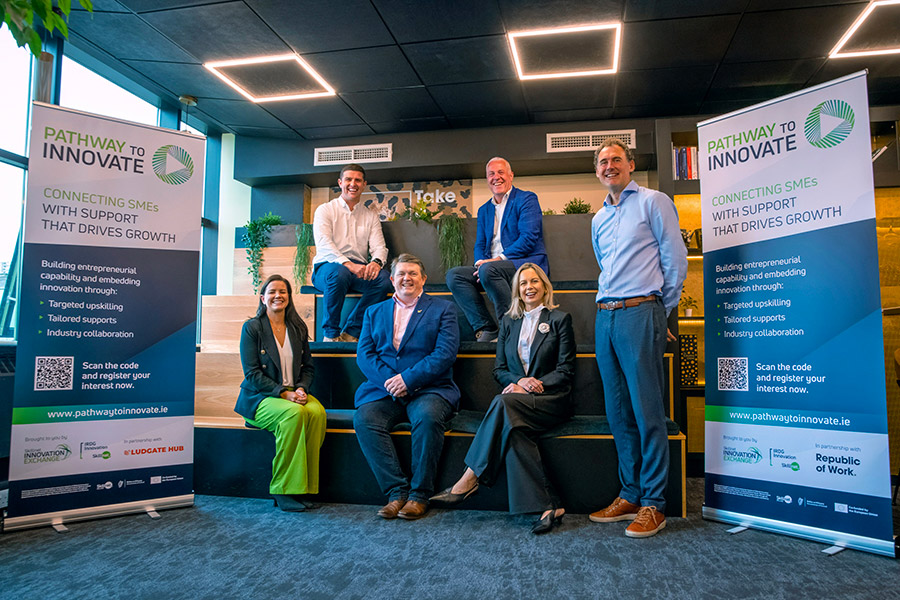Sponsored Content
For many SMEs and business owners, digital transformation sounds like a daunting prospect, not least because its name suggests ripping it all up and starting again. Rodney Moore (pictured), CEO of IT Group (part of Magnet Networks), explains what it all means.
The process of digital transformation should be the perfect marriage between your existing systems and a core network that is designed to be used and give control back to the business. Most definitions of digital transformation describe its effect rather than what it is -- a process of digital integration designed specifically to suit your business.
Digital integration will bring simplification, control, intelligence and the knowledge that customers are receiving an enhanced experience.
At present, most companies’ digital assets consist of many layers of bespoke devices and functions controlled by different people on multiple levels. All of these devices and applications sit on the network but generally operate independently of each other, controlled and supported by different teams, both in-house and from third-party vendors.
Typically, an organisation will have a voice solution supported by the provider, data servers controlled by an IT team, printers supported by facilities management companies and devices in a room coming under what we term user management. The challenge for most companies is that they generally do not have the skillset to get all these applications integrated and talking to each other.
Organisations need a single point of contact for all of their IT requirements — voice data, printing access, video conferencing, security network, infrastructure, user devices, video, WiFi and real-time information about their building. Quite simply, digital transformation blends all of this together on a single core network. With an overall integrated service, any issues are solved with one phone call, with the cost advantages that this entails.
It's integration, not transformation
Digital transformation is not just a solution to present issues but a solid foundation for the future. However, the phrase transformation implies that the company is changing completely, which is often not the case.
After identifying the company’s needs, we at IT Group take existing or new technologies and integrate them into a single-core IP network solution. This is only the foundation stone for the company’s future, and all additional services can be layered on top of that. As your market changes, you have a resilient integrated network that can adopt emerging technologies.
Integration gives businesses a foundation that will allow you to use, adapt and tailor whatever technologies that your business demands now and into the future.
It’s not all about new kit
Genuine digital transformation has very little to do with the acquisition of new technology. An organisation will have made wise investments over time, and the last thing it needs is to end up with a lot of new technology but the same old problems of fragmentation. What it needs is for the technologies to integrate and function well together, and very often companies don’t have that skillset in-house.
The bottom line with digital integration is that the new stuff is not necessarily better than the old stuff. This is why when choosing a supplier you should choose one that is agnostic, rather than a reseller where you become part of an up-selling process.
Our expertise is in identifying where you will get the most benefit, and how integration may make your old technology work better, with our assistance. Our engagement model is to speak to everyone in the business that is involved, so that we have a comprehensive understanding of your business and then come back with a workable solution
A well-designed integration process gives a more manageable risk in terms of the spend on technology rather than huge capital investments. This is far less risky than a costly lift and shift solution.
It is all about the experience
Any capital investment in digital integration has to be married to an operational dividend. Companies immediately see that their supply chain, processes or CRM systems improve, thereby improving the customer experience, and allow a greater flow of better quality data and information, improving the company’s capability, flexibility and innovation. Integration also generally means operational savings, and dealing with one provider rather than several.
Control is everything, and everything can be controlled
A TV is no longer a TV — it is an integrated digital media network device. Most organisations have got TVs, phones and internet, and when there is a problem they have to turn to three or four providers to find both the source of the issue and the solution. Because all of these things are now IP devices sitting on a network, we are able to understand where the origin of the problem is, far more quickly than the organisation can at present.
The aim of digital integration is to implement a new core network on which all existing devices sit and talk to each other. It is a change in the way that you are using your assets to make them more accessible to the people who use them. Ultimately, everything must come back to a central control, which is generally your IT department, bringing all the disparate points back to one location.
It must be driven from the top
Digital integration will not work unless it is driven from the top of the organisation. Business leaders are generally faced with so many challenges around change that there is timidity about doing things quickly, and a reluctance to abandon existing processes. However, digital integration is not something that you can choose to ignore — you have already made the investment, you just need to implement a change for the future.
As a prime example, all of the screens that we use in our own headquarters are nine years old — we have upgraded them significantly and cost-effectively through digital integration as part of our network. The old technology now displays today’s information and tomorrow’s challenges.
The organisations that we work least successfully with are those where that leadership layer doesn’t respect or understand what their existing technology is doing or not doing. The moment of truth is when the leader sees that the technology has improved the CRM, or the understanding of calls coming in, or response times — which in turn has enhanced the customer experience.
Integration is the key to being a smart business
If you want to be smart, you have to integrate first. In order for a location to be smart, everything in the business processes and technology has to be integrated behind it. There is no point having sensors all over a building if it is not integrated at a central point of control.
Smart brings savings, and with integration organisations will save money in the long term, downtime will be reduced and customer experience will improve.
It all starts with connectivity
Businesses considering digital integration need to realise the importance of quality connectivity. You cannot build a solid digital foundation without a proper connectivity piece. Even in the last two years, connective technology has moved on massively, but many internet-critical companies are still living on the offering that they signed up to five years ago.
While 68% of companies in Ireland say that they have a digital transformation strategy, it is very difficult to run a smart warehouse with a 12Mb connection. If you are an online dependent company and you’re paying €29.50 for your broadband, rather than securing dedicated internet access such as that provided by Magnet Networks, then you are vastly undervaluing the importance of connectivity to your business.
If you lose connectivity, or even broadband quality, then you don’t just lose business days, you lose revenue and possibly customers.
• IT Group specialises in digital transformation through integrating solutions into open managed services. Clients include Paddy Power Betfair, Doyle Collection, and the Department of Foreign Affairs and Trade. IT Group was recently acquired by Magnet Networks Group, which sees the connectivity company offer a range of managed services to the market.
Tel: 1800 789 789
Web: www.magnetnetworks.com












